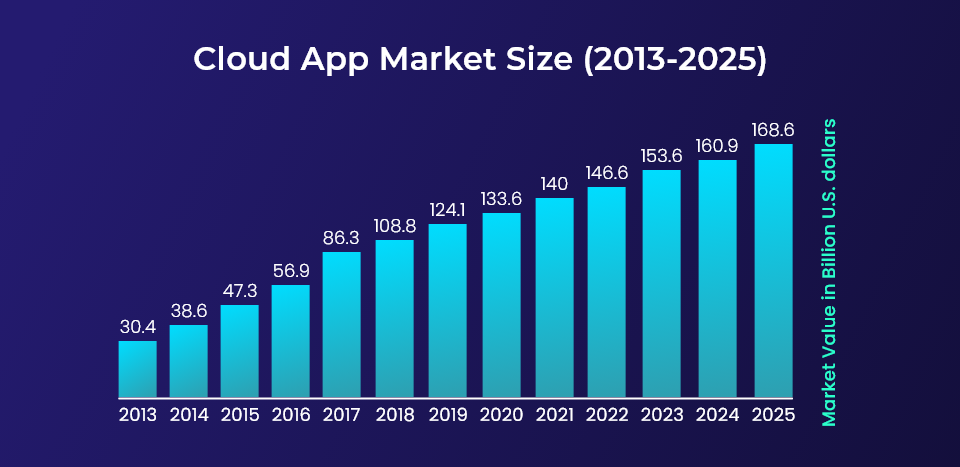In the dynamic realm of technology adoption, the surge in demand for cloud-based applications has significantly transformed the digital landscape. Businesses are witnessing an uptick in demand for cloud application development.
The enigma surrounding cloud-based applications is gradually unraveling, as businesses realize the need to harness cloud services effectively. Most of the applications used today are cloud-based owing to their immense potential of scaling and stability.

What is a cloud-based application?
A cloud-based app operates via the internet, storing and processing components on the cloud. Processing occurs on remote servers managed by APIs, while user devices act as input tools without disrupting primary processes. In cloud app development, data resides in cloud infrastructure like data lakes and data warehouses, potentially cached on devices, minimizing device requirements. Cloud storage temporarily holds data offline, syncing when online. Users can configure backups, optimization, compression, and encryption. Accessible via various devices, cloud apps transcend browser limitations. They integrate third-party cloud services like AWS or Azure through APIs, allowing easier customization compared to web apps.
How does a Cloud-Based App works
When a user engages with an app through their web browser or mobile device, the intricate task of data processing is undertaken by potent remote servers. These servers, in the context of cloud-based apps, serve as cloud storage units. As such, the user’s phone or computer acts solely as a user interface or input mechanism, as the intensive processing load is borne by the cloud. This arrangement significantly alleviates the processing burden on the user’s device, consequently optimizing app performance.
Cloud-based development becomes especially pertinent for applications necessitating instantaneous user interaction. Consider scenarios such as real-time location sharing and on-demand communication in delivery and mobility apps. The cloud emerges as a paramount solution to facilitate seamless real-time processing within such contexts.
Advantages of embracing cloud-based solution
Cost efficiency
Effective allocation of funds is a global concern for businesses. By adopting cloud-based application development, you gain swift access to essential information while conserving resources required for launching a cloud-based app. Additionally, expenses are optimized as you pay only for the utilized cloud services, avoiding unnecessary space or features.
Data consistency
Cloud services eliminate concerns about inconsistent reporting and data quality. Businesses can centralize data storage in a uniform format, enabling universal access to updates within the designated cloud space. This cohesive approach minimizes human errors and ensures data integrity.
Enhanced flexibility
In contrast to local server hosting, the cloud empowers organizations with heightened flexibility. Moreover, scaling up bandwidth is seamless, obviating the need for complex and costly IT infrastructure upgrades. This newfound autonomy and adaptability can significantly bolster overall business capabilities.
Robust scalability
Conventional local solutions possess limitations in accommodating expanding workloads. However, cloud-based application development offers rapid scalability, adeptly aligning with evolving business demands. This elasticity enables seamless adjustments to accommodate changing conditions, allowing efficient management of a larger user base and contributing to amplified profitability.
How to create your own cloud-based app
Got an awesome app idea that you think could thrive in the cloud? Developing a cloud-based application might be just the ticket! Whether you’re into mobile apps or web platforms, there are a few key steps to follow on your cloud journey.
Know your audience and needs
Before diving in, understand who your app is for and what problems it’ll solve. Map out how your app fits into their lives.
Build a dream team
Outsourcing cloud development services can make your app-building experience smoother. They’ll help plan, design, and estimate costs.
Plan your architecture
Decide on the way your app will be structured. Will it use Infrastructure as a Service (IaaS), Software as a Service (SaaS), or Platform as a Service (PaaS)?
Choose your tech stack
Pick tools and technologies that align with your app’s features. Think about scalability too. Will your app withstand growth?
Monetization plan
Determine how you’ll make money from your app. Whether it’s paid downloads, in-app purchases, or ads, plan your monetization model.
Development and testing
Build your app in sprints (short cycles) using Scrum and Agile methods. Cloud-native applications are a hit for their customization and efficiency.
Quality Check
Before launch, thoroughly test your app. Outsourced development teams can help ensure high-quality results.
Launch and Maintain
Release your app on Google Play or the App Store. Keep in mind that each platform has its process and costs.
Developing a cloud-based app is an exciting adventure, offering flexibility and scalability. So, if you’re ready to take your app idea to the cloud, follow these steps and watch your creation thrive!
Conclusion
In conclusion, the future of cloud-based apps holds the promise of reshaping the technological landscape with unprecedented effectiveness, flexibility, and scalability. These apps are set to revolutionize the way we interact with technology, catering to the evolving needs of businesses and individuals alike. As industries become more interconnected and fast-paced, the inherent ability of cloud-based apps to seamlessly adapt and scale provides a robust foundation for innovation and growth. Their cost-effective models, coupled with enhanced accessibility and collaborative capabilities, position them as essential tools for global connectivity and productivity. With their boundless potential to integrate emerging technologies and empower developers to push boundaries, cloud-based apps are poised to be the driving force behind a transformative digital era, where agility and efficiency pave the way for a dynamic and interconnected future.
